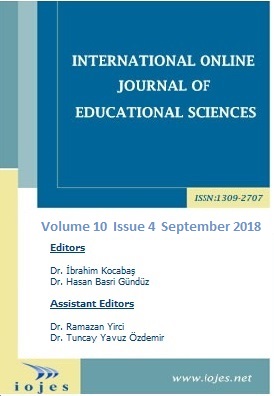Author :
Abstract
Keywords
Abstract
Three-dimensional (3D) printers, can essentially be defined as tools that allow individuals to take physical outputs of objects as 3D that they previously designed through computer-aided support programs. In this context, it is aimed to determine teachers' views on the instructional use of 3D printers within the scope of the present research. In current research case study method was used as one of the qualitative research methods. In the scope of this study, 10 males and 19 females, totally 29 participants, who were teacher at a middle school, were included into this research. It was observed that the new 3D printers, which were introduced in learning environments, were appreciated by the teachers who will implement this technology and the teachers were influenced by the existing technology. It can be said that the use of 3D printers for teaching purposes is extremely beneficial. In the field of education, especially in the basic fields of Science and Mathematics, 3D printers are thought to have a significant impact.
Keywords
- Alan Kendrick, J. D. (2013). 3D Printing: The Next Industrial Revolution? Available at: https://www.nerac.com/wp-content/uploads/2014/07/3D-Printing-Dec.pdf (Accessed 20.06.2018)
- Berman, B. (2012). 3-D printing: The new industrial revolution. Business horizons, 55(2), 155-162.
- Blauch, D. N., & Carroll, F. A. (2014). 3D Printers Can Provide an Added Dimension for Teaching Structure– Energy Relationships. J. Chem. Educ., 91 (8), 1254−1256.
- Büyüköztürk, Ş., Çakmak, E. K., Akgün, Ö. E., Karadeniz, Ş. and Demirel, F. (2009). Bilimsel araştırma yöntemleri (5. bs.). Ankara: PegemA Yayıncılık.
- Choi, J. Y., Das, S., Theodore, N. D., Kim, I., Honsberg, C., Choi, H. W., & Alford, T. L. (2015). Advances in 2D/3D printing of functional nanomaterials and their applications. ECS Journal of Solid State Science and Technology, 4(4), P3001-P3009.
- Çallı, L., & Taşkın, K. (2015). 3D Yazıcı Endüstrisinin Oluşturacağı Yeni Pazarlar ve Pazarlama Uygulamaları. ICEB 2015. Uluslararası Vizyon Üniversitesi, Gostivar, Makedonya.
- Demir, E. B. K., Çaka, C., Tuğtekin, U., Demir, K., İslamoğlu, H., & Kuzu, A. (2016). Üç boyutlu yazdırma teknolojilerinin eğitim alanında kullanımı: Türkiye’deki uygulamalar. Ege Eğitim Dergisi, 17(2), 481-503.
- Eisenberg, M. (2013). 3D printing for children: What to build next? International Journal of Child-Computer Interaction, 1(1), 7-13.
- Eisenhardt, K. M. (1989). Building theories from case study research. Academy of management review, 14(4), 532- 550.
- Howeidy, D. R., & Arafat, Z. (2017). The Impact of Using 3D Printing on Model Making Quality and Cost in the Architectural Design Projects. International Journal of Applied Engineering Research, 12(6), 987-994.
- Hudson, N., Alcock, C., & Chilana, P. K. (2016, May). Understanding newcomers to 3D printing: Motivations, workflows, and barriers of casual makers. In Proceedings of the 2016 CHI Conference on Human Factors in Computing Systems (pp. 384-396). ACM.
- Ishengoma, F. R., & Mtaho, A. B. (2014). 3D printing: developing countries perspectives. arXiv preprint arXiv:1410.5349.
- Jo, W. (2016). Introduction of 3D Printing Technology in the Classroom for Visually Impaired Students. Journal of Visual Impairment & Blindness, 110(2), 115-121.
- Kılıçer, K. (2008). Teknolojik yeniliklerin yayılmasını ve benimsenmesini arttıran etmenler. Anadolu Üniversitesi Sosyal Bilimler Dergisi. 8(2), 209-222.
- Krassenstein, E. (2014). Why 3D Printing Needs to Take Off in Schools Around the World. Available at: https://3dprint.com/27743/3d-printing-benefits-schools/ (Accessed 20.06.2018).
- Lu, M., Su, J., Wang, W., & Lu, J. (2017). Visualization of Kepler’s laws of planetary motion. Physics Education, 52(2), 025006.
- Martelli, N., Serrano, C., van den Brink, H., Pineau, J., Prognon, P., Borget, I., & El Batti, S. (2016). Advantages and disadvantages of 3-dimensional printing in surgery: a systematic review. Surgery, 159(6), 1485-1500.
- Miles, M. B., & Huberman, A. M. (1994). Qualitative data analysis: An expanded sourcebook. 1994. Beverly Hills: Sage Publications.
- Olla, P. (2015). Opening Pandora’s 3D printed box. Technology and Society Magazine, 34(3), 74-80.
- Rogers, E. M. (2010). Diffusion of innovations. Simon and Schuster.
- Shaikh, M. (2017). 3D printer. Available at: http://www.aiktcdspace.org:8080/jspui/bitstream/123456789/ 2037/ 1/ aiktcDspace2037 (Accessed 21.06.2018).
- Szulżyk-Cieplak, J., Duda, A., & Sidor, B. (2014). 3D printers–new possibilities in education. Advances in Science and Technology Research Journal, 8(24), 96-101.
- Torres, K., Staśkiewicz, G., Śnieżyński, M., Drop, A., & Maciejewski, R. (2011). Application of rapid prototyping techniques for modelling of anatomical structures in medical training and education. Folia morphologica, 70(1), 1-4.
- Ventola, C. L. (2014). Medical applications for 3D printing: current and projected uses. Pharmacy and Therapeutics, 39(10), 704.
- 3dortgen (2017). Çağan Kuyucu. Available at: http://www.3dortgen.com/blog/3d-yazici-rehberi-2-3d- yazicilarda-kullanima-uygun-hammaddeler (Accessed 09.11.2017).





